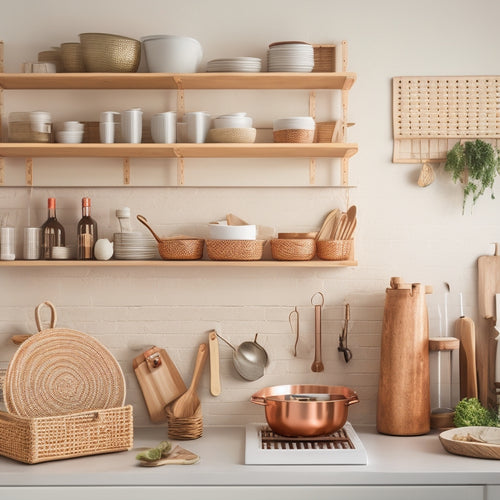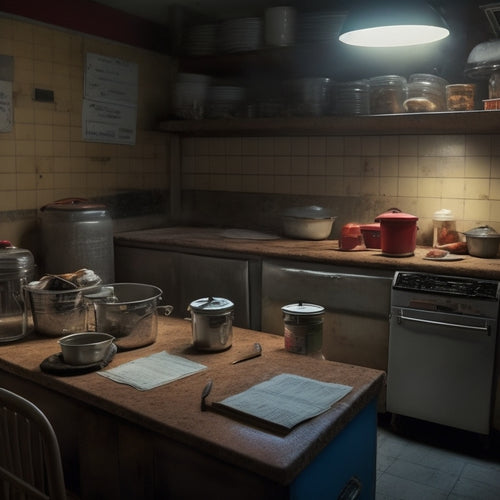
What's Holding You Back From a Clutter-Free Kitchen?
Share
You're stuck in a cycle of kitchen clutter because ineffective storage, poor categorization, and a lack of systems are preventing you from achieving the organized space you desire. You're struggling to find what you need when you need it, and maintaining your pantry organization is a constant battle. Your shelves and cabinets are cluttered, and you're not maximizing your available space. It's time to identify the specific challenges holding you back and implement tailored solutions. By addressing these key areas, you'll be on your way to a clutter-free kitchen that sparks joy and makes cooking a breeze - but first, you need to uncover the obstacles standing in your way.
Key Takeaways
• Ineffective storage solutions and poor categorization lead to disorganization and make it difficult to find items in the kitchen.
• Lack of a tailored organization system for the pantry and other kitchen areas hinders maintenance and assessment of specific needs.
• Limited budget and resources can hold you back from investing in storage options, decluttering, and organizing solutions.
• Failure to declutter and eliminate unnecessary items prevents the creation of a peaceful and organized kitchen space.
• Inadequate labeling and signage make it difficult to maintain organization and find items quickly and efficiently.
Kitchen Pantry Organization Challenges
What's preventing you from achieving the organized kitchen pantry of your dreams, and what're the common obstacles that stand in your way? When it comes to pantry organization, many people struggle with cluttered shelves, expired food, and a general sense of chaos.
One major challenge is ineffective kitchen storage. If your pantry lacks adequate shelving, baskets, and bins, it's simple for items to get jumbled and disorganized.
Another obstacle is poor categorization. When similar items aren't grouped together, it's tricky to find what you need when you need it.
Additionally, many people struggle with maintaining their pantry organization over time. Without a system in place, it's simple for clutter to creep back in.
To overcome these challenges, it's crucial to assess your pantry's specific needs and create a tailored plan for pantry organization. By implementing a few simple strategies, you can transform your kitchen storage and enjoy a clutter-free pantry that makes meal prep a breeze.
Limited Budget Holding You Back
You don't have to break the bank to achieve a clutter-free kitchen. With a little creativity, you can find affordable storage options that fit your style and budget.
Affordable Storage Options
Five budget-friendly storage solutions can transform your kitchen without breaking the bank. You don't have to sacrifice style or functionality to stay within your budget. Instead, explore creative solutions that maximize your kitchen's space and potential.
Start by implementing space-saving ideas like installing shelves, hooks, or a pegboard on walls or cabinets. These will help keep frequently used items within easy reach while keeping countertops clear.
Consider repurposing items you already own, such as using a vintage window or a wire basket as a unique storage container. You can also find affordable storage bins, baskets, and containers at thrift stores or online.
Think vertically by using stackable containers or shelves to store infrequently used items. Label each container or shelf to guarantee you can quickly find what you need.
DIY Decluttering Hacks
To take your kitchen organization to the next level, utilize DIY decluttering hacks that can be implemented with minimal to no cost, allowing you to overcome budget constraints and achieve a clutter-free space.
You can upcycle containers, such as old mason jars, tin cans, or cardboard boxes, to store kitchen essentials like spices, utensils, or cleaning supplies. Get creative with labels and decorations to give them a personalized touch.
Another area to focus on is creative shelving ideas. Repurpose an old ladder or crate to create a unique storage unit for cookbooks, plates, or kitchen gadgets.
You can also use adhesive hooks or magnets to hang utensils, pots, or pans, freeing up valuable counter space. By implementing these DIY hacks, you'll be able to maximize your kitchen's storage capacity without breaking the bank.
Prioritizing Essential Items
With a limited budget, identifying the most important items to prioritize in your kitchen organization project is crucial, as it allows you to allocate resources effectively and make the most impact.
To achieve this, you need to adopt a decluttering mindset, focusing on essential organization that simplifies your kitchen space. Start by categorizing your kitchen items into must-haves, nice-to-haves, and unnecessary items. Be ruthless – if you haven't used it in the past year, it's likely you won't miss it.
Next, simplify your priorities by identifying the areas that need the most attention. Is it the cluttered countertops, the overflowing pantry, or the disorganized cabinets? By focusing on one area at a time, you can create a sense of accomplishment and momentum.
A minimalistic approach will help you prioritize what's truly essential, freeing up space and resources for more important things. Remember, it's not about having the most stuff, but about having what you need to cook, entertain, and enjoy your kitchen.
Cluttered Shelves and Cabinets
You're likely familiar with the frustration of rummaging through cluttered shelves and cabinets, only to find that the one item you need is buried beneath a pile of unnecessary kitchen gadgets. This clutter not only wastes your time but also makes your kitchen look disorganized and chaotic.
Cluttered shelves and cabinets are often a result of overcrowded drawers and cluttered countertops, where items are carelessly tossed and forgotten. A messy fridge can also contribute to the clutter, as expired or spoiled food lingers, taking up valuable space.
To tackle this issue, start by clearing everything out of your shelves and cabinets. Sort items into categories, such as baking supplies, cooking utensils, and dinnerware. Be ruthless – get rid of anything broken, duplicate, or unnecessary.
Once you've purged your collection, organize items in a logical and accessible way. Assign a home for each item, making sure it's easy to find and put back. By doing so, you'll create a more functional and peaceful kitchen space that allows you to cook and entertain with ease.
Lack of Storage and Space
Limited kitchen space and inadequate storage solutions can render even the most organized systems ineffective, compelling you to juggle appliances, cookbooks, and gadgets in a constant struggle for counter real estate. This lack of storage and space can quickly lead to clutter, making it challenging to maintain a clean and organized kitchen.
To combat this, it's crucial to think innovatively about storage and optimize your kitchen's layout. Here are some space-saving solutions that are vital:
-
Install shelves, hooks, or a pegboard on walls or ceilings to maximize vertical storage
-
Invest in multi-functional appliances or gadgets that serve more than one purpose
-
Use stackable containers or baskets to store dry goods, spices, or cooking utensils
-
Incorporate a kitchen cart or island with built-in storage to increase counter space
-
Implement a 'zone' system, where similar items are stored together in designated areas
Inefficient Use of Corners
When you take a closer look at your kitchen, you'll likely find that the corners are often the most underutilized spaces.
You're probably letting valuable real estate go to waste, and it's time to reclaim it.
Corner Shelving Solutions
Optimizing corner spaces is essential, as traditional corner shelving often results in dead zones that hinder accessibility and visualize clutter. You're probably wasting valuable space in your kitchen, and it's time to revamp your corner shelving solutions.
Innovative design and space-saving solutions can transform these areas into functional and organized zones.
Here are some creative storage ideas to maximize your corners:
-
Install a carousel or lazy Susan to make it easy to access items in the back of the corner
-
Use a corner shelf with a built-in basket or container to store spices, oils, or utensils
-
Invest in a pull-out corner drawer or cabinet to store heavy or bulky items
-
Add a corner organizer system with adjustable shelves and baskets to customize your storage needs
-
Incorporate a diagonal corner shelf to create a visually appealing and functional display area for cookbooks, decorative items, or infrequently used kitchen gadgets.
Hidden Storage Options
You've probably noticed that even with optimized corner shelving, there are still areas in your kitchen that can benefit from hidden storage options, such as the dead space behind a wall or beneath a countertop. These often-overlooked spaces can be leveraged to maximize your kitchen's storage potential. By incorporating clever storage solutions, you can turn these hidden areas into functional storage spaces.
For instance, you can install a slide-out spice rack or a pull-down pot lid organizer behind a wall or beneath a countertop. These creative solutions not only free up counter space but also keep your kitchen organized and clutter-free.
To make the most of these hidden storage options, take inventory of your kitchen's dead spaces and think creatively about how you can utilize them. Consider installing a pull-out trash can or a hidden appliance garage to keep your kitchen tidy. By incorporating these clever storage solutions, you'll be amazed at how much more functional and organized your kitchen can become.
With a little creativity and planning, you can turn your kitchen into a clutter-free haven that you'll love spending time in.
Disorganized Kitchen Essentials
Your kitchen essentials, such as pots, pans, utensils, and gadgets, are likely scattered throughout your kitchen, making it difficult to find what you need when you need it. This disorganization can lead to wasted time, frustration, and even affect the quality of your cooking.
Here are some common signs of disorganized kitchen essentials:
- You're constantly searching for a specific utensil or gadget, only to find it buried under a pile of other items.
- Your countertops are cluttered with appliances, cookbooks, and other items, making it hard to find space to prepare meals.
- You have multiple items that serve the same purpose, but can't decide which one to keep or use.
- You're using valuable storage space for items that are rarely used.
- You're struggling to keep your kitchen drawers organized, with items spilling out every time you open them.
Implementing simple solutions, such as using drawer dividers and reducing countertop clutter, can make a significant difference in the functionality and efficiency of your kitchen. By taking control of your kitchen essentials, you'll be able to cook with confidence and enjoy the space where you spend a significant amount of time.
Poor Lighting and Visibility
Inadequate lighting and poor visibility in your kitchen can hinder your ability to prepare meals efficiently, leading to mistakes, accidents, and frustration. A well-lit kitchen is essential for a clutter-free space, as it allows you to see what you're doing and where everything is.
| Before | After |
|---|---|
| Dark and dimly lit kitchen | Bright and airy kitchen with new lighting fixtures |
| Cluttered countertops | Clear countertops with organized utensils and ingredients |
| Hard-to-reach shelves | Adjustable shelves with easy access to frequently used items |
| Messy pantry | Organized pantry with labeled containers and baskets |
| Overwhelming kitchen space | Streamlined kitchen with a designated workstation |
Unnecessary Kitchen Items
Now that you've optimized your kitchen's lighting and layout, it's time to tackle the clutter itself, starting with the unnecessary items that are taking up valuable space and collecting dust.
Adopting a decluttering mindset is vital to achieving a functional kitchen. It's important to recognize that a clutter-free kitchen requires lifestyle changes, and it begins with letting go of items that no longer serve a purpose.
Take a closer look at your kitchen and identify the items that are hindering your kitchen's functionality. Consider the following:
- Gadgets you've never used or haven't used in a year
- Duplicate items or unnecessary kitchen tools
- Broken or damaged items that can't be repaired
- Kitchen gadgets that are no longer suitable for your cooking style
- Items that don't align with your simplified approach to cooking
Inadequate Labeling and Signage
Every kitchen has areas where items are stored, but without clear labels, it's easy to forget what's inside containers or struggle to find what you need in a hurry. Inadequate labeling and signage can lead to clutter and disorganization, making meal prep and cooking a frustrating experience.
By incorporating labeling benefits into your organizing tips, you can create a more efficient kitchen. Start by labeling containers, shelves, and drawers with their contents, making it easy to identify what's inside. This simple step can save you time and reduce stress.
When it comes to signage placement, consider placing labels at eye level or near the front of containers to guarantee they're easily readable. Additionally, use decluttering techniques like categorizing and grouping similar items together to make the most of your labeling efforts.
Related Posts
-

Revolutionize Your Kitchen Storage With These Ideas
You're ready to revolutionize your kitchen storage! Start by incorporating ladder-accessible shelves and utilizing cl...
-

Deighton Associates Awarded for Excellence in Asset Management
You're likely curious about Deighton Associates' recent recognition for excellence in asset management. They've recei...
-

Food Safety Inspections Uncover Startling Violations
Food safety inspections in local establishments have uncovered a disturbingly high number of critical violations, put...


